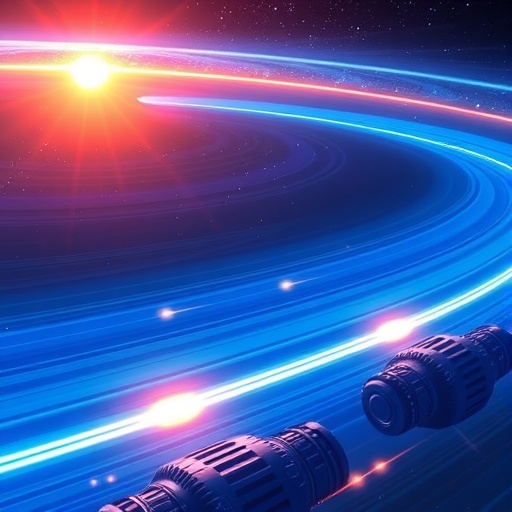The dawn of gravitational wave astronomy marks a new era in our understanding of the universe, as groundbreaking advancements by facilities such as the LIGO, Virgo, and KAGRA collaborations pave the way for stunning astronomical observations. These facilities are instrumental in detecting and localizing transient gravitational-wave signals, which are ripples in spacetime caused by some of the most violent and energetic processes in the cosmos. The advancements in sensitivity and reliability of these detectors promise unprecedented prospects for observing cosmic events that were previously shrouded in mystery.
Gravitational waves were first theorized by Albert Einstein in his general theory of relativity, but it wasn’t until the successful detection by LIGO in 2015 that this phenomenon was confirmed. This monumental achievement opened doors to a plethora of research opportunities aimed at deciphering the nature of black hole mergers, neutron star collisions, and other extraordinary astrophysical events. The collaboration of Advanced LIGO, Advanced Virgo, and KAGRA has been fundamental in enhancing our ability to detect gravitational waves from various sources, whether they are the in-falls of dense stellar remnants or the mergers of supermassive black holes.
Observational strategies have evolved significantly, allowing researchers to pinpoint the sources of gravitational waves with astounding precision. The integration of advanced techniques such as electromagnetic follow-up observations with optical and radio telescopes has further strengthened the field of multimessenger astronomy. By combining gravitational wave data with electromagnetic signals, scientists can explore not only the binary systems that produce these waves but also the atmospheres and environments surrounding them, offering a more comprehensive view of the universe.
One of the critical advancements in the detection process is the sensitivity improvements made in LIGO and Virgo’s interferometers. These upgrades contribute to their ability to discern incredibly faint signals, which are often buried beneath noise, ensuring that even the most distant and subtle events can be studied. The enhanced sensitivity translates into a broader observational horizon, allowing for the detection of gravitational waves from events occurring billions of light-years away. Such events serve as valuable cosmic laboratories that illuminate our understanding of fundamental physics and the behavior of matter under extreme conditions.
As we delve into the universe’s most cataclysmic events, the capability to localize gravitational-wave sources has drastically improved. This localization is crucial for enabling targeted follow-up observations across the electromagnetic spectrum. For instance, understanding the origins of a gravitational wave event can often lead to identifying its counterpart in gamma rays or x-rays, providing a fuller picture of the explosion’s aftermath. Consequently, the collaboration between gravitational wave astronomy and traditional astrophysics leads to fruitful outcomes in the understanding of phenomena like kilonovae, the remarkable explosions following neutron star mergers.
The importance of collaborative efforts cannot be overstated in this field. Numerous observatories have joined forces to actively engage with signals detected by LIGO and Virgo in real-time. For instance, after the detection of a gravitational wave event, participating institutions rapidly harness their telescopes to observe the corresponding electromagnetic signatures, unveiling secrets hidden within these cosmic events. This landscape of collaboration encourages cross-disciplinary research, providing a richer context for interpreting the data gathered through gravitational wave detectors and traditional observations.
As more gravitational wave events are cataloged, the scientific community anticipates a wealth of information pertaining to the population properties of different astronomical objects. Current and future studies may reveal disparities in the distribution of black hole masses, providing critical insights into their formation processes. For example, how do these binary systems evolve, and what affects their eventual merger? Understanding these parameters holds dominion over our broader comprehension of galaxy formation and the lifecycle of stars.
Moreover, the analysis of transient gravitational waves can probe other exciting areas of physics, including fundamental questions about the nature of spacetime and gravity. Constraining theories through observational data allows physicists to examine Einstein’s framework against alternative theories and modifications to gravity. These explorations could unlock profound revelations about the fundamental laws governing our universe and even inform us about possible connections to dark matter and dark energy.
As the landscape of gravitational wave detection continues to evolve, the advent of next-generation observatories promises to leapfrog current capabilities, potentially detecting even weaker signals from more distant events. Projects like LIGO’s third observation run and KAGRA’s early operations in Japan exemplify a global commitment to harnessing advancements in technology and coordination. The groundwork laid by these facilities heralds a future where the universe will be viewed in an entirely new light, revealing phenomena previously thought to be unfathomable.
Leading-edge theories suggest that gravitational waves may even provide evidence for phenomena such as primordial black holes, which could drastically alter our understanding of inflation and the early universe. Future observations may offer important clues about how these enigmatic entities interact with traditional baryonic matter, giving rise to new hypotheses about cosmic evolution. Each discovery builds upon the last, creating an intricate web of knowledge that continuously enhances our astronomy toolkit.
In conclusion, gravitational wave detections hold extraordinary promise for reshaping our understanding of the cosmos. As we integrate data from gravitational waves with other forms of astronomical information, we begin to form an increasingly detailed and nuanced picture of the universe’s structure, dynamics, and history. These collaborations symbolize not just a technological triumph but an exploration into the heart of physics itself, pushing the boundaries of human knowledge into realms previously thought unreachable. The journey into the cosmos continues as researchers harness the strengths of gravitational wave astronomy, making discoveries that will resonate through generations.
Subject of Research: Gravitational Wave Astronomy
Article Title: Prospects for observing and localizing gravitational-wave transients with Advanced LIGO, Advanced Virgo and KAGRA
Article References:
Abbott, B.P., Abbott, R., Abbott, T.D. et al. Prospects for observing and localizing gravitational-wave transients with Advanced LIGO, Advanced Virgo and KAGRA.
Living Rev Relativ 21, 3 (2018). https://doi.org/10.1007/s41114-018-0012-9
Image Credits: AI Generated
DOI:
Keywords: Gravitational Waves, LIGO, Virgo, KAGRA, Multimessenger Astronomy, Black Holes, Neutron Stars, Cosmic Events, Astronomy, Physics, Einstein, General Relativity.




